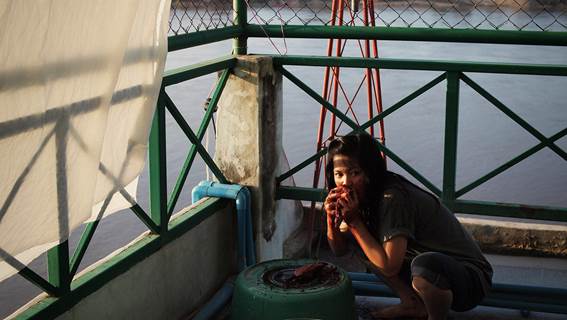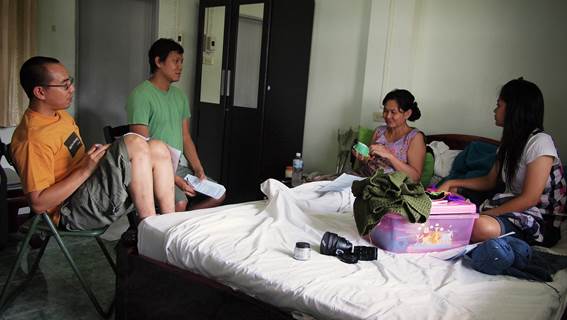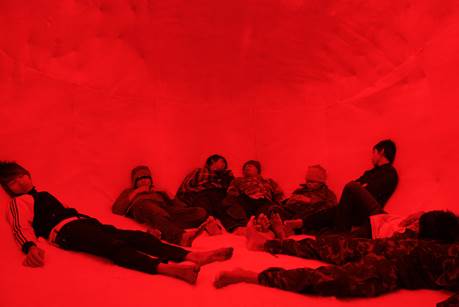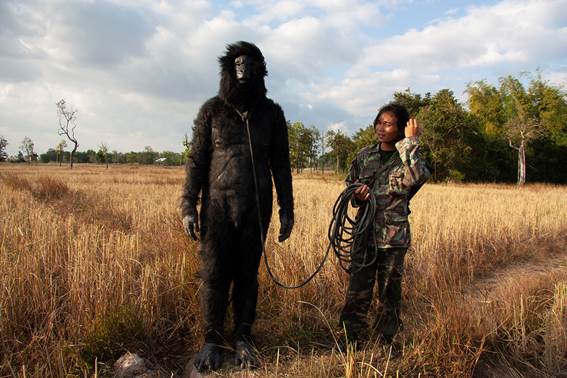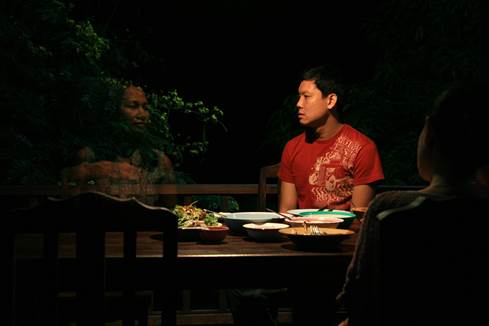Introduction: Breaking up with Representation
The seeds for this article were planted on a winter evening in 2010 when, together with two friends, I went to see Apichatpong Weerasethakul’s Uncle Boonmee Who Can Recall His Past Lives at the Prince Charles Cinema in London. I didn’t know anything about Weerasethakul at the time, and still remember vividly the impression that the film made on me, the exhilarating “bloc of sensations” (Deleuze and Guattari 1994) that took me over, even though I felt I lacked the tools to fully make sense of the stories being told. Around the same time, I also discovered Eduardo Viveiros de Castro’s book Cannibal Metaphysics (2010 in the Spanish edition) - an encounter that triggered an analogous trepidation, if only at a conceptual level. In both instances, at least in my experience as a reader/spectator, the encounter with animist practices and ideas was not represented as other and thus pacified, but instead taken seriously as the basis for seeing and thinking otherwise. In other words, both works rejected the plane of epistemology and enabled a certain openness to ontological multiplicity: it was not about seeing the world differently, but about seeing different worlds. (Figure 1).
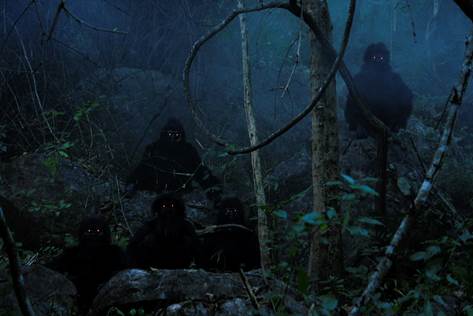
Source: Courtesy of Kick the Machine Films
Figure 1 Production still from Uncle Boonmee Who Can Recall His Past Lives
I have continued to find it productive to think across the work of Weerasethakul and Viveiros de Castro ever since, particularly since I started teaching visual anthropology in the UK1 and felt the need to open “lines of flight” (Deleuze and Guattari 1987) from the filmic practices most commonly associated with this discipline, namely reflexive realism (see Loizos 1993) and more recently sensory observational cinema (see Grimshaw and Ravetz 2009; MacDougall 2006). Weerasethakul’s work, it seemed to me, could act as a bridge of sorts between Jean Rouch’s ethnofictions (central to the history of ethnographic film and yet still considered somewhat marginal in relation to the canon, see Stoller 1992) and contemporary cinematic practices that also straddle the line between fiction and documentary, such as some of Pedro Costa’s works produced in Fontainhas (e.g., Juventude Em Marcha [2006]; Cavalo Dinheiro [2014]). All of the aforementioned films share an inventive, performative realism that disentangles representation from evidentiary or documentary concerns and that, in doing so, provides an exciting opening that also resonates with current debates in anthropology at large.
Elizabeth Edwards (2011, 2012), Christopher Pinney (2011), and Deborah Poole (2005) are among the authors that have pointed out how the emphasis on the critique of representation that dominated visual anthropology from the late 1970s until recently became an obstacle to recognizing the multiple ways in which images exist among us, including their materiality and their performativity. In this sense, the shift towards studying what images actually do (and what we do with them) proposed by these authors produced an important analytic displacement towards how images, as socio-material entities, constitute and are constituted by social relations. In making this argument, Edwards and others were echoing the work of Alfred Gell (1998), whose contribution to the anthropology of art consisted precisely of articulating the “agency” of artworks as performative components in the production of social relations. Gell argued that it was more productive for anthropologists to focus on what artworks do rather than what they may mean, therefore advocating an anthropology of art orientated towards “the study of social relations in the vicinity of objects mediating social agency” (1998, 7).
This desire to move away from the analytics of representation is also central to a number of current debates in anthropology, including recent reappraisals of the Writing Culture-era debates (e.g., Elhaik and Marcus 2010; Marcus 2012), contemporary trends in the anthropology of art (e.g., Sansi 2015; Schneider and Wright 2010, 2013), conceptualizations of indigenous media that focus on their agentive and performative aspects (e.g., Raheja 2007), and ontologically-oriented work (e.g., Henare et al. 2007). The latter is particularly relevant to the aims of this article, and I will return to it below in relation to certain aspects of Weerasethakul’s work. Before doing so, however, I would like to briefly elaborate on my use of the concept of “non-representation”, which I take from non-representational theory (NRT).
NRT may be described as an approach to the study of social life characterized by its focus on process, relationality and heterogenous assemblages, developed in dialogue with the philosophy of Gilles Deleuze and Actor-Network Theory (Thrift 2008). In the context of this article, and in relation to Weerasethakul’s work, I am particularly interested in how NRT claims to “take representation seriously[;] not as a code to be broken or as a[n] illusion to be dispelled rather representations are apprehended as performative in themselves; as doings” (Dewsbury et al. 2002, 438). In other words, NRT is concerned with conceptualizing representations as presentations, that is, “as things and events that enact worlds, rather than being simple go-betweens tasked with re-presenting some pre-existing order or force” (Anderson and Harrison 2010, 14). The use of “non-representational” is therefore connected to a critique of the established notion of representation, which is arguably bound to a hierarchical understanding of the relationship between original and copy, as well as an unproblematic equivalence between identity, repetition and sameness. As Marcus Doel puts it:
Through representation, what has already been given will come to have been given again. Such is its fidelity: to give again, and again, what has always already been given, without deviation or departure. Such is its fidelity to an original that is fated to return through a profusion of dutiful copies; an original whose identity is secured and re-secured through a perpetual return of the same, and whose identity is threatened by the inherent capacity of the copy to be a deviant or degraded repetition, a repetition that may introduce an illicit differentiation in the place ostensibly reserved for an identification. (Doel 2010, 117)
In contrast, NRT proposes that the notion of representation be rethought under the axis of difference, rather than identity, that is, “bypassing the subservient relationship between one medium and another… and treat[ing] everything usually regarded as representational (e.g. words, concepts, ideas, perceptions, and images) as events in their own right” (Doel 2010, 120). This results in a vitalism where the world is not given in advance, but is rather a performative achievement, continuously (re)made.
Drawing from these theoretical insights, and in dialogue with Weerasethakul’s work, in this article I argue for an ethnographic cinema beyond representation, understood, that is, as an inventive, performative, world-making activity. As Kier Swaffield (2013) argues, certain cinematic practices are capable of enabling other ways of seeing the world ─ or rather enacting other worlds to be seen. According to Swaffield, films such as Weerasethakul’s may be conceptualized as non-representational in as much as they “diffract” rather than “reflect” reality (Barad 2007) and engage in an “inventive rearrangement” (Jensen and Rödje 2010) of source material which transforms both the material itself and our relation to it. In short, they enact a sensory experience that produces a difference that matters, be it a break from habitual thought, an affective response of the kind I alluded to above when remembering my first encounter with Uncle Boonmee, or some other unexpected outcome.
The rest of this text is concerned with teasing out some of the implications of non-representational approaches to film for ethnographic cinema. More specifically, through an engagement with four of Weerasethakul’s films (Mysterious Object at Noon [2000]; Mekong Hotel [2012]; Uncle Boonmee Who Can Recall His Past Lives [2010] and Tropical Malady [2004]), I discuss the politics and aesthetics of a performative practice engaged in the production of multiple worlds (and thoughts).
Documenting Fictions
Apichatpong Weerasethakul (b. 1970) grew up in Khon Kaen, north-east Thailand, where his parents worked as physicians. He studied architecture at the local university before completing an MFA in Filmmaking at the Art Institute of Chicago. Weerasethakul’s first full-length feature, Mysterious Object at Noon (2000), emerged out of his MFA thesis. It takes the form of a road movie of sorts, with a small film crew travelling through Thailand, north to south, engaging with and filming a number of people in the process. Apparently disjointed at first, the film eventually reveals itself as a “documentary fiction” which includes both a re-enacted story and the process of its making. The work is organized using the surrealist method of the “exquisite corpse” where each participant contributes a fragment to the story, but is only aware of the previous fragment. Schoolchildren, a fish seller, a talkative old lady and a theatre group, amongst others, contribute (and in some cases act out) segments. The result is a story that drifts and turns: it starts with a disabled child taught at home by a visiting teacher. One day a round object rolls down the latter’s skirt and transforms into a boy with superpowers who defends them against a witch-tiger.
By asking the participants to contribute fictions, rather than “true” personal stories, Weerasethakul creates a filmmaking device where “rather than affirming or denying an identity with his subjects, he takes pains to complicate any conflation[.] The non-professional locals become active agents, performing and improvising in their own idioms, their own spaces” (Teh 2011, 603). The result is a landscape of "minor languages", vernacular utterances, and under-represented others. The film is possessed by the imagination, fears, anxieties and passions of those involved in it; it acts as a medium for (a fragmented) collective enunciation. Crucially, this enunciation is not grounded in the realist logic of representation, but rather of invention. Through the use of fiction, Mysterious Object avoids hosting fixed subject positions or identities and instead generates the conditions for a process of co-creation.
The result is indeed reminiscent of Jean Rouch’s ethnofictions, such as Moi, un noir (1958) or Jaguar (1967). Gilles Deleuze’s writing on these films is particularly relevant to the present discussion. Framed within a discussion of the “power of the false”, he argues that Rouch’s work breaks with a certain understanding of the distinction between fiction and reality; indeed, cinema-verité destroys “every model of the true so as to become creator and producer of truth” (Deleuze 1997, 151). The following passage, which I cite at length, clarifies Deleuze’s argument:
What is opposed to fiction is not the real; it is not the truth which is always that of the masters or colonizers; it is the story-telling function of the poor, in so far as it gives the false the power which makes it into a memory, a legend, a monster… What cinema must grasp is not the identity of a character, whether real or fictional, through his objective and subjective aspects. It is the becoming of the real character when he himself starts to ‘make fiction’, when he enters into ‘the flagrant offence of making up legends’ and so contributes to the invention of his people… He himself becomes another, when he begins to tell stories without ever being fictional. And the film-maker for his part becomes another when there are ‘interposed’, in this way, real characters, who wholly replace his own fictions by their own story-telling. Both communicate in the invention of a people. (1997, 150)
For my part, I would like to refocus the emphasis on the filmic apparatus itself. This is not to deny the emancipatory qualities that these experiences may have for the participants and the filmmakers, but rather to add to these the transformation in the cinematic device that this method allows. I would argue that films in and of themselves also become-another, which is to say that the concatenation of relations they are part of (production strategies, screening, spectatorship, etc.) is reshuffled. In the case of Mysterious Object, this takes place in a playful manner through an experience of confusion, disorientation and non-resolution that structures both the filmic text and its reception. Most conventions and expectations regarding either documentary or fictional features are ignored in Mysterious Object; it is a film that moves freely in the uncertain space between the two, bypassing a clear-cut narrative, any sense of character development, the very distinction between actors and characters, and so on. Writing along similar lines about the politics of storytelling, David Teh conceptualizes Weerasethakul’s work in terms of a “resistance to fixity and certitude[.] A history without dates, a map without place-names, a documentary without facts, [Mysterious Object] dramatises this condition, prompting a reconsideration of the epistemological status not just of film, but of narrative per se” (Teh 2011, 609).
Devices for Collective Enunciation
The discussion above points towards an important aspect of the works I am attempting to reclaim for (another) ethnographic cinema: their participatory nature. Far from an incidental occurrence, the engagement of a multiplicity of agents in the production of these films is central to their being: they are the result of a process of co-creation, often tentative in a way not dissimilar to research. I will develop this idea with reference to Weerasethakul’s Mekong Hotel (2012), a film that offers a rare insight into his work method. In contrast to Mysterious Object, where the coherence of the film relied on the “imposition” of the exquisite corpse method, Mekong Hotel is a much more open-ended film, structured around -or rather moving freely between- five narrative levels:
A vampire movie entitled Ecstasy Garden about a pob ghost who eats the intestines of animals and humans;
the rehearsals for that film;
the recording of a guitar soundtrack, presumably for that film;
conversations between the actors and Weerasethakul, in which they share their personal stories related to the border between Thailand and Laos which is where they are based and the film takes place;
and the exploration of the border landscape itself as the swollen river that doubles as a border threatens to flood the region.
(Figure 2)
Unlike many films structured around the making of a film (or their own making, for that matter), there is no attempt to signify any of the layers listed above as ontologically superior, that is, as more real or important. Everything is filmed in the same way, with the same patient, fixed, deep focus and wide shots. These Bazinian framing strategies do not attempt to inscribe a human perspective (as handheld shots or a shallow depth of field may do), but rather produce an ample stage where a number of stories, characters, actors, landscapes, questions, and so on may be hosted. The camera rarely moves or chases the action; characters may enter and/or leave the scene, in turn providing an acute sense of the frame and its outside. The shots’ generous duration, their amplitude and stillness hence become welcoming devices. May Adalol Ingawanij describes it in terms of an “ontological democracy”:
The assemblage of fragmentary images rehearses the weaving of a narrative, registering the duration of a story’s metamorphosis. In this duration the figures in Mekong Hotel tell stories about the local ruse to adorn the village with rustic, royalist touches prior to the visit of the king’s granddaughter - a cosmetic pastiche of the royal ideology of self-sufficiency, one which would last precisely as long as the princess’s visit. The figure that is at once Auntie Jen and a melancholic ghost remembers being subjected to the military’s intense bombardments of anti-communist slogans during her youth. Chuckling, she tells a tale, to the homely rhythm of her crochet needle and the ethereal melody of a hesitant guitar rehearsal, of compulsory training with heavy rifles at the tender age of thirteen, in case the communists attacked her village. Surviving yet remembering the violence of a totalising ideology; eluding a contemporary one that’s ringing increasingly hollow - these are the truths playing beyond the frame, that struggle to find expression in the world, true tales woven into the meandering of tall tales, thi len, thi jing. (Ingawanij 2013a, 2)
Mekong Hotel’s emphasis on storytelling indeed speaks to Weerasethakul’s approach to filmmaking at large. In numerous interviews and public talks, he has candidly explained how his projects rely increasingly on the people and the places he works with, and in “feeding from the environment.”. He has explained how his characters are becoming more and more like the actors that play them. The latter are invited (expected, even) to contribute to the project with their experiences, some of which become part of the script. This is certainly the case of Jenjira Pongpas who plays Auntie Jen in Mekong Hotel and has contributed elements of her biography and experience to a number of Weerasethakul’s films, including Uncle Boonmee Who Can Recall His Past Lives (2010), Cemetery of Splendor (2015), Syndromes and a Century (2006) and Blissfully Yours (2002) (see Regnier, 2015). Hence, the script becomes a participatory device in which Weerasethakul’s own research and a collective process of rehearsal and improvisation can take place. The script is a hosting mechanism, flexible enough to accommodate a range of heterogeneous materials and to respond to the interests and experiences of those participating in it. At an event at the Tate Modern in London in April 2016,2 Weerasethakul explained that he was trying to let go of (experimental) film school “tricks”, as well as filmmaking “rules and structures,” and concentrate instead on creating the right conditions for working with a group of people and certain locations - a method which could pass as an apt description of ethnographic fieldwork!
(Figure 3).
I find Deleuze and Guattari’s concept of “collective assemblages of enunciation” (1986) useful for thinking about this aspect of Weerasethakul’s work. The concept refers to a device without a master voice, possessed by a proliferation of enunciations (heteroglossia) and whose function is not to represent, but rather to enact. Deleuze and Guattari developed it in relation to Franz Kafka’s work, which they read as political not in the sense of offering a critique, but rather as a means of escape: “It was the world and its representation that he made take flight and that he made follow these lines. It was a question of seeing and speaking like a beetle, like a dung beetle” (Deleuze and Guattari 1986, 46-47). The Kafka analogy is also relevant in relation to making explicit the tension between these centrifugal strategies of collective enunciation and the centrality of the (single) author. Indeed, despite their openness and multivocality, Weerasethakul’s films have a distinct and easily recognizable feel that can only be attributed to his authorship. It is in order to underline this tension I describe his work as participatory, rather than collaborative,3 the latter being a term I would reserve for more horizontal practices that also redistribute (or challenge) authorship. To reiterate, it is arguably the fact that Weerasethakul’s films remain under his creative direction (including setting the terms under which others participate in them) that has produced a consistent -and remarkable- body of work that we can evaluate on the basis of its aesthetic merit, rather than purely on methodological or ethical aspects, as tends to be the case with collaborative practices (Bishop 2012).
History in the Subjunctive
If I am getting ready to speak at length about ghosts, inheritance, and generations, generations of ghosts, which is to say about certain others who are not present, nor presently living, either to us, in us, or outside us, it is in the name of justice... It is necessary to speak of the ghost, indeed to the ghost and with it. (Derrida 2006, xviii)
Ghosts, spirits and supernatural presences of different kinds and demeanors, occupying a variety of bodies, human and otherwise, are a recurring presence in Weerasethakul’s films (as well as a focal point of interest in the existing literature, e.g., Bordeleau et al. 2017; Carew 2013; Chung 2012; Mello 2015). I’m interested here in thinking with these multiple presences in relation to Derrida’s “politicization” of ghosts and the question of learning to speak with others. Running through Weerasethakul’s work as a continuous (if latent) text, is an oblique engagement with the military repression of communist insurgents in the North of the country between the 1960s and early 1980s. His films have created hospitable spaces where the ghosts of a silenced past can be summoned, and with them subaltern stories uttered. In this sense, their understated simplicity is misleading, these films are in fact rather monumental in their ambition to host anything and everything: ghosts, dreams, memories, experiences, non-humans, transubstantiated beings that alert “spectators to the motion of otherwise imperceptible life forces in the existing world” (Ingawanij 2013b, 99). As fellow Thai artist and ghost connoisseur Rirkrit Tiravanija puts it:
Unlike many narratives of the past, which were based on the architecture of fear, what we find today in the works and films of Apichatpong could be read, understood and interpreted as a narrative of difference. In the narrative of Apichatpong, the world of the living coexists with the world of spirits, where ghosts are not a source of fear but of spiritual exchange, where difference and otherness can be better understood as nature and as living. (Tiravanija 2011, 32)
Weerasethakul’s best known film, Uncle Boonmee Who Can Recall His Past Lives (2010), is a good example of this. The film is closely related to a larger art project called Primitive (2009), which explored the town of Nabua in northeast Thailand, near the border with Laos. During the Cold War, this was an area to where Maoist militants had retreated, escaping repression. However, the town was then occupied by the Thai military from the 1960s to 1980s in the fight against communism, and insurgents were abused and massacred systematically. These events, along with an ancient legend about a widow ghost who would abduct any man who entered her empire, earned Nabua the name of “widow town.” Primitive takes the shape of an immersive, multiscreen installation focusing on the lives of young men. For the purposes of this article, I am interested in one of the projects that was organized as part of the making of Primitive: a series of workshops in which the young men that participated (grandchildren of the repressed communist farmers), who cannot relate to a past that has been silenced, embarked on the task of inventing new memories and re-imagining the history of their town. The stills that were produced in these workshops are one of the many elements from Primitive that found their way into Uncle Boonmee, to which I now turn.
In essence, Uncle Boonmee is a film about a man (Boonmee) who is dying due to a kidney disease, which he is convinced is related to having killed too many communists in the past. As he prepares himself for death, he visits and is visited by his family, including the ghost of his dead wife and his estranged son, who has become a jungle monkey. In a particularly striking sequence, just before Boonmee dies, he lies down in a cave and dreams about a future in which the authorities hunt down beings from the past and make them disappear. The sequence is entirely made of stills that were produced by young men in the process of creating Primitive. (Figure 4)
We can see how Weerasethakul’s method produces fertile ground in which a multiplicity of stories can flourish and be incorporated into the filmic apparatus. Collectively produced, these projects may perhaps also be capable of producing new collectivities. For those involved in Primitive, it was an opportunity to regain a past they never had, and therefore to think about a future they did not possess.4
Many of Apichatpong’s films deal in one way or another with the history of Thailand. Now, in what mode does cinema usually stage the encounter with history? Mainly in the factual mode of the indicative. Think of Hollywood’s historical dramas and their obsession with realism as well as a very conservative notion of mimetic “method” acting. Or think of the many documentaries which, even if they re-write history, tell us “how it really was”… It is in this context that Apichatpong’s cinema really makes a difference, proposing an encounter with history in the conditional and subjunctive modes, asking not only what could have happened but also how the past could still be acting today, asking what the past desires. (Bordeleau et al. 2017, 19)
Weerasethakul’s break with the descriptive, indicative mode of realist cinema; his subjunctive, speculative leap, is one of the key gestures I’d like to reclaim for visual anthropology, and more specifically ethnographic film. Rather than an instrument for capturing pre-existing ideas or relations through representational techniques, cinema (and anthropology) can become vehicles for invention, that is, devices for enacting new relations and ideas. As Gabriel Dattatreyan and I have written elsewhere, “invention” refers to a creative, immanent mode of engagement with the subjects and objects of the world (and the worlds of these subjects and objects), through which unforeseeable knowledge, events and encounters may be produced (Dattatreyan and Marrero-Guillamón, forthcoming). (Figure 5)
Taking Animism Seriously
I will now return to the resonances between Weerasethakul’s and Viveiros de Castro’s work that were alluded to in the introduction, by way of a discussion around “animism”. My point of reference will be Weerasethakul’s Tropical Malady (2004). This is a film divided into two autonomous parts: the first tells the story of a soldier and a country boy that embark on a friendship/courtship, the second, entitled A spirit’s path, on which I will focus here, follows a lone soldier (played by the same actor) in the jungle in pursuit of a shaman’s spirit trapped in the body of a tiger.
At first, the three protagonists, the soldier, the shaman-tiger and the jungle, are distinct enough. One can identify them as separate entities and follow their actions. As the film progresses, however, a series of displacements occur. First, the overwhelming visual opacity of the jungle and its aural density increasingly dominate the sensory experience, downgrading the human character to one among many presences. This is accompanied by Weerasethakul’s skillful shifts in the film’s point of view, which detaches itself from a human-centric position and enables the spectator to see what the shaman-tiger and the jungle see. Moreover, the neat ontological separation between humans, animals, spirits and plants is blurred by the multiple metamorphoses at play: not only are beings other than the sole human capable of speech, but the soldier himself undergoes a process of becoming-animal/becoming-jungle that sees him transformed into something or someone else, although we cannot be sure what.
Tropical Malady’s remarkable form and feel led James Quandt (2009, 76) to argue that rather than about animism, this was a film of animism - that is, an animist film. Put differently, instead of telling an animist story (from an external point of view), A spirit’s path is an animist story, i.e., it enacts an animist world. I should clarify that my use of the term “animism” is aligned to contemporary anthropological theories, where it is “no longer treated as the mistaken belief in an animated nature… but as an extension of social relationality to nonhumans in ways that imply a set of ontological assumptions distinct from the one with which anthropology traditionally works” (Kohn 2015, 317). Philippe Descola, whose work among the Achuar in Ecuador has been key to the development of these contemporary theories of animism, defines it as one of the four great ideal-type ontologies, characterized by a “continuity of interiority” between humans, animals, spirits and certain plants (i.e., they are all persons who share a “culture”) which are, however, differentiated through the “discontinuity of their exteriority,” that is, their bodies (Descola 2013). The implications of this ontological arrangement are unpacked by Eduardo Kohn (2015, 317): “given this understanding, a shaman can become a jaguar by wearing as clothing elements of a feline body, such as canine teeth and spotted hides, that make jaguars distinctive predatory beings. A psychic continuity permits movement across physical discontinuities.”
I would argue that the second half of Tropical Malady plays along these lines: it is the continuity of interiorities that allowed the shaman to become trapped in the body of tiger in the first place. Conversely, it is only when the body of the soldier starts to transform and resemble that of a jungle animal (i.e., when physical discontinuity is overcome) that he can start to behave like the tiger he is chasing. Ultimately, the film’s own shifting perspective between the soldier, the tiger and the jungle is made possible (indeed fluid) because of the “cultural” continuity between them. Rather than representing, or describing, an external ontological arrangement, A spirit’s path performs it through cinematic means. In other words, it enacts the possibility of a sensory experience of animism.
I see in these strategies a possible audio-visual response to the challenge that Viveiros de Castro poses for anthropology: to “take seriously” the ontologies of the peoples one studies, that is, not as “worldviews” but as “worlds that are viewed”, not as “opinions” but as “objectively experienced worlds” (Viveiros de Castro 2010). As he further explains:
The language of ontology is important for one specific and, let’s say, tactical reason. It acts as a counter-measure to a derealizing trick frequently played against the native’s thinking, which turns this thought into a kind of sustained phantasy, by reducing it to the dimensions of a form of knowledge or representation, that is, to an ‘epistemology’ or a ‘worldview’. (2003, 18)
The quote above makes clear that for Viveiros de Castro, ontology is a line of flight from the language of representation. Indeed, he argues that only by acknowledging the existence of alternative ontologies and engaging with them as proper metaphysical systems can anthropology be in a position to close its “karmic cycle” and take on its new mission as the “theory-practice of the permanent decolonisation of thought” (2010, 14) and “the science of the ontological self-determination of the world’s peoples” (2003, 18). He has attempted such a task in his groundbreaking work on Amerindian perspectivism - an ontology he defines as “perpendicular” and incommensurable to ours (contrary to Descola, who classifies as a variant of animism; see Latour 2009).
Weerasethakul’s work, I believe, provides an indication of how visual anthropology may participate in this politico-conceptual endeavor. His films offer an experiential encounter with animism on its own terms, as a situated response to its presence in Thailand’s North-East, the marginal and under-represented region of Isaan where most of his films take place. As David Teh explains, the region has always been a buffer zone, subject to forced resettlements, acculturation (the imposition of the Thai language over Lao), assimilation (into Siam), foreign (American) military presence, communist insurgence and repression, and a refuge for militant students fleeing political repression. These multiple layers are reflected in the region’s cultural and religious specificity:
…The north-east is exemplary, its open, carnivalesque folk traditions offering an antithesis to the closed, hierarchical and ceremonious forms of official Siamese culture. Isaan’s animism and religious syncretism, and its matriarchal social structure, were gradually overcoded by a mono-logical Siamese-Buddhist patriarchy, and less gradually after the reforms of the fifth reign (1868 - 1910). So Buddhism, while integral to Isaan life, has become so somewhat against the grain of an animist substrate. (Teh 2011, 602)
This animist undercurrent animates most of Weerasethakul’s films, which are populated by ghosts, where people may reincarnate as animals, where the same body may be occupied by different spirits, where animals speak with humans. Ingawanij speaks of “performative realism” to refer to this “layering of diegetic worlds in which material immaterialities [such as ghosts (see figure 6)] are perceived as real” (2013b, 92), a feature of Weerasethakul’s cinema she has also defined ─ as mentioned above ─ as enacting an “ontological democracy” (2013a).
Conclusion: Another Ethnographic Film Is Possible!
The images of art do not supply weapons for battles. They help sketch new configurations of what can be seen, what can be said and what can be thought and, consequently, a new landscape of the possible. But they do so on condition that their meaning or effect is not anticipated. (Rancière 2009, 103)
These are times of renewal in ethnographic film. Its identification with documentary aesthetics (itself a changing field) is more equivocal than ever: experimental films produced under the umbrella of Harvard’s Sensory Ethnography Lab, such as Leviathan (Paravel and Castaing-Taylor 2013), have enjoyed success and aroused interest beyond the academy; the improvisational films of Australian indigenous collective Karrabing (see Lea and Povinelli 2018) have been recognized by top art institutions in the West, including London’s Tate Modern and Paris’ Centre Pompidou; and a number of works combining ethnographic engagement, collaboration and fiction (in a Jean Rouch vein) have succeeded in making the ethnographic film festival rounds (for instance, Les Sauters [Wagner, Siebert and Sidibé 2016], Little Go Girls [de Latour 2016], Travel [Mai 2016] or La Fiancée du Nil [Mills-Affif 2015]).
In this context, Apichatpong Weerasethakul offers an inspirational body of work that ─ I have argued ─ may be reclaimed for the project of an ethnographic cinema beyond the aesthetics (and politics) of representation. His films are inventive rather than descriptive, speculative rather than authoritative, multiperspectival rather than bound to a human point of view. Albeit not self-defined as anthropological in any way, Weerasethakul’s work emerges from a para-ethnographic engagement with people and places. His films are good hosts; hospitable, open to a multiplicity of beings and structured around situations of patient listening. They are also good mediums; assemblages of collective enunciation devoid of the voice of the Master, possessed by their guests, that is, by the subjects and entities that populate and animate them. Indeed, they have systematically explored subaltern experiences and silenced histories in Thailand and subtly rebelled against hegemonic national narratives.5
Relatedly, these films cultivate what may be described as, following Martín Savransky, an “alter-realism”, that is, a “realism that takes the risk of asserting the reality of what is deemed improbable, implausible, marginalised, suppressed, irrelevant, even scandalous, and seeks to draw out its possible implications for the transformation of what is considered credible, reliable and serious” (2017, 22). Put differently, Weerasethakul’s cinema embodies a non-representational or performative realism that is not limited to reality as it actually exists, but rather contributes to overflowing reality from the margins. His films dare to experiment with other realities and their effects on (our) thinking (Savransky 2017).
These are some of the reasons why I believe Weerasethakul’s films are good to think with in relation to reimagining what ethnographic cinema may be(come). They provide a conceptual and methodological toolbox for non-representational aesthetics, as well as an inventive model of political commitment. Indeed, these two aspects are connected: the break with documentary aesthetics depicted in this article is emancipatory in a Deleuzian sense, that is, as a form of resistance to confining reality and being confined by it. This another ethnographic cinema would no longer aim to just depict (or even to produce just depictions, pace Godard), but rather to create: new entities, new subjectivities, new thoughts, new worlds. Its political horizon would not be defined by resistance, debunking or demystification, but rather by aspiring to create lines of flight: new conditions of possibility, alter-ontologies, redistributions of the sensible (Rancière 2009), bifurcations in the real. As Deleuze and Guattari stated when referring to Kafka, it all starts with the recognition of a plurality of expressions, which in turn “break forms, encourage ruptures and new sproutings” (1986, 28).













